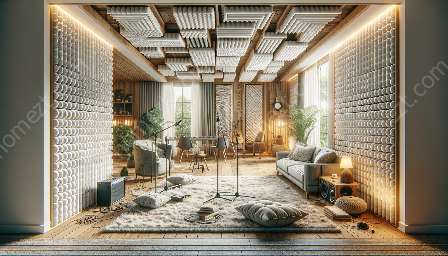Soundproofing existing walls and ceilings in homes is a crucial step in creating a peaceful and quiet living environment. Whether you are dealing with noisy neighbors, street traffic, or internal household noise, effective soundproofing can significantly reduce unwanted sound transmission, thereby enhancing comfort and privacy. In this comprehensive guide, we will explore various soundproofing techniques, materials, and practical tips to help you achieve optimal noise control in your home.
Understanding the Importance of Soundproofing
Before delving into the specific methods of soundproofing walls and ceilings, it's essential to understand the significance of this process. Soundproofing primarily aims to mitigate the transmission of airborne and impact noise between different spaces. By reducing the transfer of sound waves through walls and ceilings, you can create a more peaceful and insulated indoor environment, free from disturbances and distractions.
Assessment of Existing Noise Issues
The first step in soundproofing existing walls and ceilings involves assessing the specific noise issues within your home. Identifying the sources of noise, understanding the nature of the sound, and determining the areas where noise penetrates most can help you develop targeted soundproofing solutions. Common sources of noise in homes include traffic, neighbors, appliances, and internal activities, such as footsteps and conversations.
Effective Soundproofing Techniques
Several effective techniques can be utilized to soundproof existing walls and ceilings in homes. These techniques include:
- Adding Mass: Increasing the density of walls and ceilings by adding mass-loaded vinyl, acoustic panels, or drywall can effectively block sound transmission.
- Decoupling: By decoupling walls and ceilings using resilient channels, soundproofing clips, or floating walls, you can minimize the transfer of vibrations and impact noise.
- Sound Absorption: Installing sound-absorbing materials, such as acoustic foam, fiberglass insulation, or fabric-wrapped panels, can help reduce reverberation and echo within a space, thereby improving overall acoustics.
- Sealing and Caulking: Addressing air gaps, cracks, and joints with resilient caulking and weather-stripping can prevent sound leaks and enhance the airtightness of walls and ceilings.
- Adding a Second Layer: Applying an additional layer of drywall with a damping compound, such as Green Glue, can effectively reduce sound transmission through walls and ceilings.
- Resilient Flooring: Installing sound-absorbing underlayment and resilient flooring materials, such as cork or rubber, can help minimize impact noise from foot traffic and movement.
Selection of Soundproofing Materials
Choosing the right soundproofing materials is crucial for achieving optimal results. Various materials, such as mass-loaded vinyl, acoustic panels, noise-reducing drywall, soundproofing compounds, and acoustic insulation, are available for soundproofing walls and ceilings. It's important to consider the specific requirements of your space, the level of sound reduction needed, and the budget constraints when selecting soundproofing materials.
Professional Soundproofing Solutions
For homeowners seeking comprehensive soundproofing solutions, consulting with professional contractors or acoustic experts can be beneficial. Professional soundproofing services may involve the installation of advanced soundproofing systems, customized acoustic treatments, and precise measurements to address specific noise issues effectively.
Practical Tips for Soundproofing Success
Along with implementing soundproofing techniques and materials, several practical tips can further enhance the success of soundproofing installations. This includes:
- Minimizing Structural Vibrations: Ensuring that heavy appliances and furniture are adequately isolated from walls and floors can reduce structural vibrations that contribute to noise transmission.
- Strategic Placement of Soundproofing Materials: Identifying and targeting specific areas of sound leakage through walls and ceilings can optimize the placement of soundproofing materials for maximum effectiveness.
- Consistent Maintenance: Regular inspection and maintenance of soundproofing materials, such as checking for air leaks, resealing joints, and replacing worn-out materials, can ensure long-term efficacy.
Creating a Serene Home Environment
By implementing the right soundproofing strategies, homeowners can transform their living spaces into peaceful havens where external disturbances are minimized, and privacy is enhanced. Whether it's creating a quiet home office, a tranquil bedroom, or a cozy entertainment area, effective soundproofing enables individuals to fully enjoy their living spaces without the intrusion of unwanted noise.
Conclusion
Soundproofing existing walls and ceilings in homes is a valuable investment that significantly contributes to the overall comfort and quality of living. By understanding the importance of soundproofing, utilizing effective techniques and materials, and incorporating practical tips, homeowners can successfully achieve optimal noise control and create an environment that promotes tranquility and relaxation.






